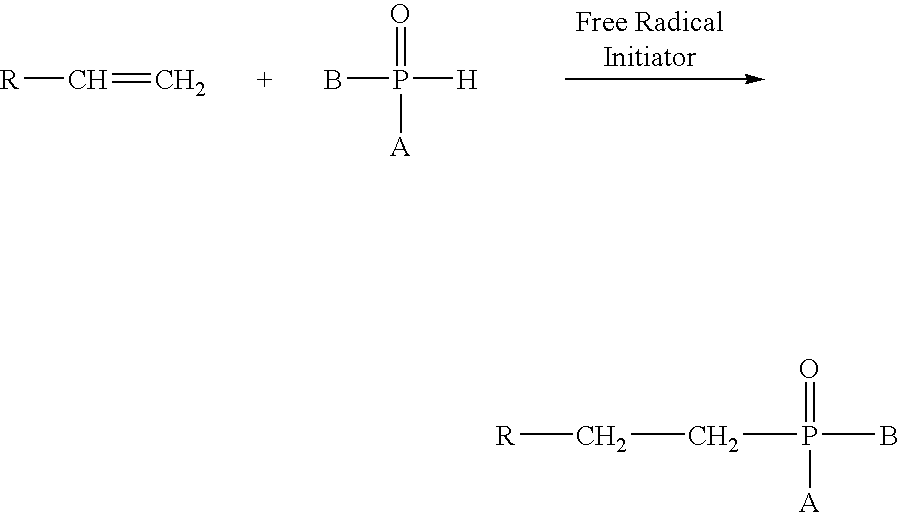Regiospecific synthesis of phosphonous acids
a phosphonous acid and regioselectivity technology, applied in the field of regioselectivity-based synthesis of phosphonous acids, can solve the problems of severe limitations on the operability of a commercial process, methods that have not found commercial application, and imposed commercial applicability, and achieves easy removal, better regioselectivity in hydrophosphorylation, and easy work-up and isolation of phosphonous acids.
- Summary
- Abstract
- Description
- Claims
- Application Information
AI Technical Summary
Benefits of technology
Problems solved by technology
Method used
Image
Examples
example 2
4-Phenylbutyl Phosphonous Acid (Using Acetone as Solvent, and pH of 6.5.+-.0.5)
To 30 wt % aqueous solution of hypophosphorous acid (41.8 ml, 0.19 moles) in acetone (100 ml) was added 4-phenyl-1-butene (5 gm, 0.038 moles) and sodium persulfate (1.8 gm, 0.00756 moles). The pH of the mixture was adjusted to 6.5.+-.0.5 with triethylamine and then heated at 77.degree. C. for 15 minutes.
The reaction mixture was worked up exactly the same way as described in Example 1 to give 6.25 gm (86.6%) of the title compound as an oil, having a purity of 97.5%.
example 3
4-Phenylbutyl Phosphonous Acid (Using Ethanol as Solvent, and pH of 6.5.+-.0.5)
To a 30 wt % aqueous solution of hypophosphorous acid (41.8 ml, 0.19 moles) in ethanol (100 ml) was added 4-phenyl-1-butene (5 gm, 0.038 moles) and sodium persulfate (1.8 g, 0.00756 moles). The pH of the mixture was adjusted to 6.5.+-.0.5 with triethylamine and then heated at 77.degree. C. for 15 minutes.
The reaction mixture was worked up exactly the same way as described in Example 1 to give 6.50 gm (86.6%) of the title compound as an oil, having a purity of 97.5%.
example 4
4-Phenylphosphonous Acid (Using Acetonitrile as Solvent, and pH of 4.5-5.0)
To a 30 wt % aqueous solution of hypophosphorous acid (41.8 ml, 0.19 moles) in acetonitrile (100 ml) was added 4-phenyl-1-butene (5 gm, 0.038 moles) and sodium persulfate (1.8 gm, 0.00756 moles). The pH of the mixture was adjusted to 6.5.+-.0.5 with triethylamine and then heated at 77.degree. C. for 15 minutes.
The reaction mixture was worked up exactly the same way as described in example 1 to give 6.0 gm (80%) of the title compound as an oil, having a purity of 96.5%.
PUM
| Property | Measurement | Unit |
|---|---|---|
| temperature | aaaaa | aaaaa |
| temperatures | aaaaa | aaaaa |
| temperatures | aaaaa | aaaaa |
Abstract
Description
Claims
Application Information
 Login to View More
Login to View More - R&D
- Intellectual Property
- Life Sciences
- Materials
- Tech Scout
- Unparalleled Data Quality
- Higher Quality Content
- 60% Fewer Hallucinations
Browse by: Latest US Patents, China's latest patents, Technical Efficacy Thesaurus, Application Domain, Technology Topic, Popular Technical Reports.
© 2025 PatSnap. All rights reserved.Legal|Privacy policy|Modern Slavery Act Transparency Statement|Sitemap|About US| Contact US: help@patsnap.com



